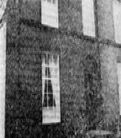The Pallottine Sisters - founded in the 19th century by 'Vincent Pallotti'
Their name comes from their Founder, St Vincent Pallotti, a Roman priest (1795 - 1850). He was overwhelmed by God's personal love of each individual person, and the life of Jesus Christ urged him to work with a degree of charity which continues to be an inspiration to all Pallottines

Pallotti lived during the turbulent time of the French Occupation of Rome - a dangerous time for the Church and the poor. In 1837 a cholera epidemic devastated Rome. Many people died, and orphaned children roamed the streets. Pallotti and his companions helped where they could. His special concern was young homeless and vulnerable girls. He placed their wellbeing into the hands of devoted capable women. Some of these became the first Pallottine Sisters. The date was Pentecost 1838. Today the work of the Sisters spans the globe.
In April 1909 the first Pallottine Sisters settled in Rochdale, Lancashire. They opened a School for Girls whose parents could not afford normal school fees. The School developed into a flourishing Grammar School. Sixty years later it was absorbed into the Rochdale System of Comprehensive Education.
From the beginning the Pallottine Sisters also cared for babies who needed a home and care. Their numbers grew fast. New Homes needed to be found. In 1952 Children and Staff moved from Lancashire to Pallotti Hall in Siddington.
The residents of Macclesfield and Congleton soon formed close bonds with the Sisters and the children. The generous circle of Friends of Pallotti provided funds, friendship and security.
By 1979 new insights and laws encouraged the placement of children in families and small units. Pallotti Hall had served its purpose. The new great need of the time was recognised as Care for the Elderly. The sale of Pallotti Hall provided funds for a purpose–built Care Home at Park Mount which opened in 1984. The site had been a charitable bequest of Mr William Goldman.
Today the Pallottine Sisters continue their caring work at Park Mount and Keele Crescent.
The Pallottine Missionary Sisters - Full History
Early History of the Pallottine Missionary Sisters of the Catholic Apostolate

The formal name of our religious congregation is the Missionary Sisters of the Catholic Apostolate and we trace our origins from the Sisters of the Catholic Apostolate. St. Vincent founded the Sisters of the Catholic Apostolate (Pallottine Sisters) in 1835 after the cholera epidemic in Rome.
Responding to the needs of orphaned girls, St. Vincent began an orphanage in the home of Giacomo Salvati. Maddalena Salvati, together with two other women, became involved in the care and education of girls. Initially, St. Vincent did not seek to form a formal religious order for women, yet he soon realised that he needed a group of women religious completely dedicated to this apostolate.
The first superior of this newly formed religious community was Elizabeth Cozzoli. On May 27, 1839, the sisters were formally recognized and admitted by Pope Gregory XVI. Several months later St. Vincent wrote the rule for the new community of religious women.
A New Congregation: Missionary Sisters of the Catholic Apostolate
First General Chapter of the Sisters of the Catholic Apostolate


On November 16, 1886, the first constitution was approved by the Church. The essential elements of St. Vincent’s charism were kept as well as the idea that the sisters would make promises rather than profess vows
After the approval, the first General chapter took place Dec. 29, 1896. Raffaella Castellani was elected as the first Mother General. By the end of Mother Raffaella Castellani’s term, there were eleven houses in Italy and five in the United States with one hundred and twelve members, and thirteen novices and postulants.

In 1890 the Pallottine Fathers were entrusted to a mission in Cameroon, Africa. However, the General Prosecutor, Fr. William Whitmee, insisted that they would only minister in this apostolate with the Pallottine Sisters. So, to prepare the young sisters for work in the mission countries, the International College Queen of the Apostles was therefore opened in Rome in 1891, under the directorship of Mother General Raffaella Castellani. Yet, because Cameroon was a German territory, only German sisters could help the Pallottine Fathers. Fr. Kugelmann from Germany helped in this regard by sending four young German girls who wanted to be Pallottine Sisters and missionaries to the mission college in Rome. In 1892, six novices were then sent to Cameroon.
Ultimately, it was then decided that Rome was not the best place to prepare German sisters for mission work, so four years later the German Pallottine Fathers received permission to open a house in Germany designated as a preparation institution for the missions. The Bishop of Limburg was pleased to have the foundation in his diocese. Fr. Whitmee asked Mother Raffaella Castellani to withdraw the Sisters sent to Rome so they could continue their training and formation in Germany.
On April 23, 1895 two sisters and seven novices left Rome for the mission college in Germany. May 23, 1895, this new community celebrated its first professions.
Mother Raffaella had a difficult time staying in touch with the sisters. Since Mother Raffaella was confident that the Pallotine Fathers had taken the responsibility of their sisters’ formation, Mother Raffaele made the difficult decision to allow this group to form a new congregation.
This was the beginning of the Missionary Sisters of the Catholic Apostolate commonly known as the Pallottine Missionary Sisters.
The first constitution for the sisters was approved in 1901. First General Chapter took place in 1905 and Sr. Felizitas Massenkiel was elected as the first Superior General.
From 1895-1916, the Pallottine Missionary Sisters ministered to the people of Cameroon until World War I when the German government told all German nationals to leave Cameroon. By 1916, all 80 German sisters from Cameroon returned to the mother house in Limburg, Germany.
In 1908, the Pallottine Missionary Sisters began ministering in Rochdale.
“Humble mission turned into top seat of learning” (Manchester Evening News)
IN THE beginning ... 183 Drake Street, which opened as the first convent school in 1909

THEY were two German nuns on a vital mission, to offer care and education to the children of Rochdale, but at first, they were the ones who needed looking after.
Sisters Salesia and Domenica of the Pallottine Missionary Sisters certainly faced an uphill task when they arrived in town in 1909.
In their possession was a small amount of money, a letter of introduction from the then Bishop of Salford, the Right Reverend L J Casertelli, a letter for Father Richard Campion, the parish priest of St Patrick's Church and little else.
That was not much with which to start a school and a home for the care of children. However, with a lot of hard work and the goodwill of many local people, they made progress. They found a house at 183 Drake Street which had been empty for some years so needed a thorough clean. Even so on 20 September 1909 the Convent School opened with 11 pupils aged between nine and sixteen years old. At the time of their arrival the sisters knew very little English, which proved a considerable handicap in the early days. Gradually though the sisters settled in and the school established itself.
As its popularity increased the school had to expand and in 1911 acquired premises in Como Terrace, 214-216 Drake Street. More nuns arrived from Europe to help teach at the school and work with the sick, poor and bereaved and they became a familiar sight in the town.
That became vital when the First World War broke out and contact with the sisters' Motherhouse in Limburg, near Frankfurt, was broken. It could have proved disastrous, but the people of Rochdale rallied round the Sisters and helped sustain them. Such was their support that in 1917 the school rented a cottage at Cowclough on the Whitworth moors for the nursery school children. Two years later the toddlers had to move on to Mount Pleasant, Facit, to make way for older pupils. As the school's success continued even the Sisters themselves had to move out, Brentwood in William Street being bought as a convent. Inevitably the Second World War brought problems for everyone from mainland European.
However, by then the Sisters were so much a part of Rochdale life that they were relatively unscathed. In fact, the school continued to thrive to such an extent that in 1947 both it and the convent moved to the Beechwood site in Manchester Road. There generations of children studied to the highest standard, though under a strict regime.
It was a recipe for success, so much so that in 1956 the Ministry of Education recognised it as an efficient independent grammar school. At its height it had more than 500 pupils and 35 sisters. The Sisters themselves, meanwhile, had been living in attic rooms throughout the school buildings. Their dream to have their own building began to take shape in May 1964. It finally became reality in February 1966 when the then Bishop of Salford, the Right Reverend Thomas Holland, performed the Solemn Blessing and opening of the St Vincent Pallotti Convent.
While this was a high point for the school major changes were on the way.
In the 1968 reorganisation of the education system the secondary department closed down and the juniors moved back to Beechwood.
The Sisters continued to provide top class education for almost three more decades, but the increasing cost of schooling eventually took its toll. In 1996 the town was rocked when it was forced to close because of cash problems. A year later, the site sold, the Sisters themselves were moving out of Rochdale after 88 years of dedicated service to its young people. It was left to Swiss-born Sister Hildeburga, who had taught at the convent for more than 50 years, to say the final goodbye.


